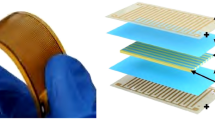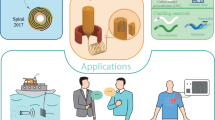Abstract
Active Fiber Composites made from piezoelectric fibers were originally developed as actuators for adaptive materials systems. Their properties, however, also allow their use as sensor or emitter-receiver in variours applications. After presenting selected characteristics, the potential of Active Fiber Composites for structural health monitoring is discussed in comparison with that of conventional piezoelectric elements.
Résumé
Des Composites à Fibres Actifs constitués de fibres piézo-électriques ont été développés initialement comme actuateurs pour des systèmes adaptifs. Les propriétés des Composites Actifs à Fibres permettent également leur application comme capteur ou émetteurcapteur. Après une discussion de certaines de leurs caractéristiques, le potentiel des Composites à Fibres Actifs pour le contrôle de santé structurale sera discuté en comparaison avec des éléments piézo-électriques conventionnels.
Similar content being viewed by others
References
Bent, A.A., Hagood, N.W. and Rodgers, J.P., ‘Anisotropic actuation with piezoelectric fiber composites’,Journal of Intelligent Material Systems and Structures 6 (1995) 338–349.
Bent, A.A. and Hagood, N.W., ‘Piezoelectric fibre composites with interdigitated electrodes’,Journal of Intelligent Material Systems and Structures 8 (1997) 903–919.
Barbezat, M., Brunner, A.J., Flüeler, P., Huber, Ch. and Kornmann, X., ‘A comparison between active and passive piezoelectric elements for damage detection in fiber-reinforced composite laminates’, Proceedings Conference on Advanced Technology in Experimental Mechanics, Japan Society of Mechanical Engineers, CD No. JSME 03-207, Paper No. OS09W0089 (2003) 5 p.
Barbezat, M., Brunner, A.J., Flüeler, P., Huber, C. and Kornmann, X., ‘Acoustic emission sensor properties of active fiber composite elements compared with commercial acoustic emission sensors’,Sensors and Actuators A: Physical 114 (2004) 13–20.
Barbezat, M., Brunner, A.J., Huber, C. and Flüeler, P., ‘Integrated active fiber composite elements: characterization for acoustic emission and acousto-ultrasonics’, Proceedings, 15th International Conference on Adaptive Structures and Technologies, ICAST 2004, at press (2004).
Melnykowycz, M., Kornmann, X., Huber, C., Barbezat, M. and Brunner, A.J., ‘Performance of Integrated Active Fibre Composites in Glass Fibre Reinforced Epoxy Laminates’ (in preparation).
Stazewski, W.J., Boller, C. and Tomlinson, G.R. (editors), ‘Health Monitoring of Aerospace Structures: Smart Sensor Technologies and Signal Processing’ (John Wiley & Sons, Chichester, 2004).
Bhalla, S., Soh, C.K. and Liu Z., ‘Wave approach for NDE using surface bonded piezoceramics’,NDT&E International 38 (2004) 143–150.
Sodano, H.A., Park, G. and Inman, D.I., ‘An investigation into the performance of macro-fiber composites for sensing and and structural vibration applications’,Mechanical Systems and Signal Processing 18 (2004) 683–697.
Brunner, A.J., Barbezat, M., Flüeler, P. and Huber, Ch., ‘Composites from piezoelectric fibers as sensors and emitters for acoustic applications’,Journal of Acoustic Emission 22, (2004) 127–137.
Kornmann, X. and Huber, C., ‘Microstructure and mechanical properties of PZT fibres’,Journal of the European Ceramic Society 24 (2004) 1987–1991.
McIntire, P. and Miller, R.K. (eds.) ‘ASNT Handbook on Nondestructive Testing, Acoustic Emission Testing’, 2nd edition, Vol. 5 (Americal Society for Nondestructive Testing, 1987).
Kornmann, X., Huber, C., Barbezat, M. and Brunner, A.J., ‘Active fiber composites: sensors and actuators for smart composite structures’, Proceedings 11th European Conference on Composite Materials, paper No. B074 (2004) 9 p.
ASTM E1067, ‘Standard practice for acoustic emission examination of fiberglass reinforced plastic resin (FRP) tanks/vessels’,American Society for Testing and Materials International 03.03 (2003) 525–539.
ASTM E 1888/E1888M, ‘Standard test method for acoustic emission examination of pressurized containers made of fibreglass reinforced plastic with balsa wood cores’,American Society for Testing and Materials International 03.03 (2003) 988–996.
prEN 14584, ‘Nondestructive testing—Acoustic emission—Examination of metallic pressure equipment during proof testing—Planar location of AE sources’, Comité Européen de Normalisation (2002) 14 pp.
ASTM E 1495, ‘Standard guide for acousto-ultrasonic assessment of composites, laminates, and bonded joints’,American Society for Testing and Materials International 03.03 (2003) 844–852.
ASTM E 1736, ‘Standard practice for acousto-ultrasonic assessment of filament-wound pressure vessels’,American Society for Testing and Materials International 03.03 (2003) 928–932.
Paradies, R. and Hertwig, M., ‘Shape control of adaptive composite reflectors’,Composites Part B. Engineering 30 (1999) 65–78.
ITI Tech report #6, ‘Acoustic emission monitoring of the trunnion shafts on Oregon DOT bridge #11377A: I-5 (Interstate) Columbia River east bridge span, Portland, Oregon’, Infrastructure Technology Institute, Northwestern University (1994).
ITI Tech report #18, “Acoustic emission monitoring of north east trunnion shaft on Oregon DOT bridge 1377A I-5 over the Columbia river, Portland, Oregon (update)”, Infrastructure Technology Institute, Northwestern University (1996).
Luo, X., Haya, H., Inaba, T., Shiotani, T. and Nakanishi, Y., ‘Damage evolution of railway structures by using traininduced AE’,Construction and Building Materials 18 (2004) 215–223.
Landis, E.N. and Shah, S.P., ‘The influence of microcracking on the mechanical behavior of cement based materials’,Advanced Cement Based Materials 2 (1995) 105–118.
Grosse, C., Reinhardt, H. and Dahm, T., ‘Localization and classification of fracture types in concrete with quantitative acoustic emission techniques’,NDT&E International 30 (1997) 223–230.
Ohtsu, M. and Watanabe, H., ‘Quantitative damage estimation of concrete by acoustic emission’,Construction and Building Materials 15 (2001) 217–224.
Grosse, C.U., Finck, F., Kurz, J.H. and Reinhardt, H.W., ‘Monitoring techniques based on wireless AE sensors for large structures in civil engineering’, Proceedings 26th Conference of the European Working Group on Acoustic Emission, Vol. BB90-CD, German Society for Nondestructive Testing (2004) 691–698.
Schubert, F., Wiggenhauser, H. and Lausch, R., ‘On the accuracy of thickness measurements in impact-echo testing of finite concrete specimens—numerical and experimental results’,Ultrasonics 42 (2004) 897–901.
Miller, R.K., Pollock, A.A., Watts, D.J., Carlyle, J.M., Tafuri, A.N. and Yezzi, J.J., ‘A reference standard for the development of acoustic emission pipeline leak detection techniques’,NDT&E International 23 (1999) 1–8.
Wood, B.R.A. and Harris, R.W., ‘Structural integrity and remnant life evaluation of pressure equipment from acoustic emission monitoring’,International Journal of Pressure Vessles and Piping 77 (2000) 125–132.
Peairs, D.M., Park, G. and Inman, D.I., ‘Improving accessibility of the impedance-based structural health monitoring method’,Journal of Intelligent Materials Systems and Structures 15 (2004) 129–139.
Akkaya, Y., Voigt, T., Subramaniam, K.V. and Shah, S.P., ‘Nondestructive measurement of concrete strength gain by an ultrasonic wave reflection method’,Mater. Struct. 36 (2003) 507–514.
Author information
Authors and Affiliations
Additional information
Editorial note Empa is a RILEM Titular Member.
Rights and permissions
About this article
Cite this article
Brunner, A.J., Barbezat, M., Huber, C. et al. The potential of active fiber composites made from piezoelectric fibers for actuating and sensing applications in structural health monitoring. Mat. Struct. 38, 561–567 (2005). https://doi.org/10.1007/BF02479548
Received:
Accepted:
Issue Date:
DOI: https://doi.org/10.1007/BF02479548




